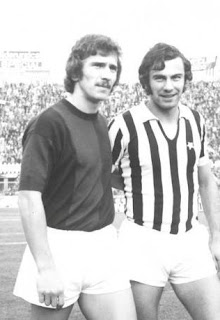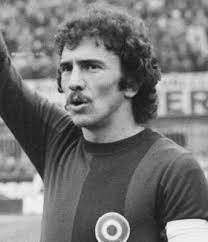The world’s first £1 million player
Giuseppe Savoldi, whose transfer from Bologna to Napoli in 1975 made him the first footballer in the world to be bought for £1 million, was born on this day in 1947 in Gorlago, a municipality a short distance from the city of Bergamo in Lombardy.Savoldi scored 168 goals in
405 matches for Bologna
A prolific striker, Savoldi’s big-money deal came four years ahead of the much heralded £1 million transfer of another striker, Trevor Francis, from Birmingham City to Nottingham Forest, which made him the first player in Britain to move for a seven-figure sum.
Napoli, who saw Savoldi as the last component in what they hoped would be a title-winning team, paid 1.4 billion lire in cash, plus two players, Sergio Clerici and Romario Rampanti, to secure his signature. The two players were valued at 600 million lire in total, which valued Savoldi at 2 billion lire, the equivalent at the time of about £1.2 million.
But where Francis, who later spent five seasons playing in Serie A, won two European Cups with Nottingham Forest, scoring the winning goal in the final in 1979, Savoldi’s move did not yield anything like the same kind of success.
Napoli had finished third and then second in Serie A in the seasons before Savoldi’s arrival but were unable to maintain their momentum. Savoldi was top scorer in each of his four seasons in Campania but i Partenopei - named after the ancient Greek settlement that evolved into Neapolis - could finish no higher than fifth in his time there.
 |
| Giuseppe Savoldi (left) with his brother, Gianluigi, who played for Juventus |
Savoldi was born into a sporting family. His mother, Gloria Guerini, was a top-level volleyball player, winning the first Italian women’s championship in the sport as a member of the Amatori Bergamo club, and his younger brother, Gianluigi, also played professional football.
Giuseppe himself was a talented all-round athlete, excelling at both the high jump and basketball, despite standing only 1.75m (5ft 9ins). His footballing ability was clear, however, and in 1965, at the age of 18, he joined his local Serie A club, Atalanta.
Initially used as a winger, Savoldi took a while to reveal his potential. In his first full season, despite being given the No 9 shirt and a licence to attack through the middle, he managed only five goals. Yet in his second season at centre-forward he was Atalanta’s top scorer with 13 Serie A goals and began to attract attention from other clubs.
At first he was not keen to leave his hometown club but his chances of winning trophies with Atalanta were remote and in 1968 he willingly signed for Bologna, where he would become one of the club’s most successful forwards, his tally of 140 goals in all competitions bettered by only three other players in the club’s history.
 |
| Savoldi (back row, third from left) made his first appearance in the |
Savoldi was capocannoniere - top scorer - for Bologna for six consecutive seasons, winning the Coppa Italia in 1970 and 1974 and the Anglo-Italian League Cup - a short-lived competition that pitched the Coppa Italia winners against the English League Cup winners over two legs - by beating Manchester City. But Bologna could not finish higher than fifth in Serie A, which persuaded him that he needed to move again.
Napoli looked like a team that could fulfil Savoldi’s dream of becoming a Serie A winner. There was an outcry in some quarters over the price Napoli were willing to pay. Many Neapolitans lived on the breadline at the time and angry trade unions complained that half of the two billion lire would have paid the city’s refuse collectors what they were owed in unpaid wages by the near-bankrupt city council. Seven goals in his first seven matches by Savoldi quelled some of the discontent, however, and had the city dreaming of a first Serie A title.
 |
| Savoldi frequently offers his opinion as a regular Serie A pundit |
He returned to Bologna in 1979 but a shadow was cast over the end of his career when he became embroiled in the infamous Totonero match-fixing scandal that saw a number of high-profile players, including the future World Cup hero Paolo Rossi, handed lengthy bans.
Savoldi, who earned seven senior caps with the Italian national team, was barred from playing for three and a half years. This was reduced to two years on appeal but effectively ended his career at the top level. He returned for one more season with Atalanta in Serie B before retiring in 1983.
For the next 15 years, he concentrated on coaching but achieved only modest success. Nowadays, he is involved in football largely as pundit, in which role he is often asked his opinion on the current fortunes of his former clubs. He lives in the Bergamo area.
 |
| Bergamo's walls have been standing for about four and a half centuries |
Bergamo in Lombardy, where Giuseppe Savoldi lives, having been born in nearby Gorlago, is a fascinating, historic city with two distinct centres. The Città Alta, upper town, is a beautiful, walled city with buildings that date back to medieval times, with a good deal of Venetian influence. The walls, which extend to more than six kilometres (3.72 miles) around the Città Alta, with four gates, go back to the mid-16th century. Designed to protect the city from enemies, they remain largely intact. The elegant Città Bassa, lower town, still has some buildings that date back to the 15th century, but more imposing and elaborate architecture was added in the 19th and early 20th centuries.
Travel tip:Piazza Maggiore in Bologna; the square is the
heart of the well-preserved city centre
Bologna, where Savoldi made his name as a player, is one of Italy's oldest cities. It can be traced back to 1,000BC or possibly earlier, with a settlement that was developed into an urban area by the Etruscans, the Celts and the Romans. The University of Bologna, the oldest in the world, was founded in 1088. Bologna's city centre, which has undergone substantial restoration since the 1970s, is one of the largest and best preserved historical centres in Italy, characterised by 38km (24 miles) of walkways protected by porticoes. At the heart of the city is the beautiful Piazza Maggiore, dominated by the Gothic Basilica of San Petronio, which at 132m long, 66m wide and with a facade that touches 51m at its tallest, is the 10th largest church in the world and the largest built in brick.
Also on this day:
1918: The birth of conductor and cellist Antonio Janigro
1926: The death of neuroscientist Camillo Golgi
1949: The birth of chef Gennaro Contaldo
2006: The death of 1938 World Cup winner Pietro Rava


No comments:
Post a Comment